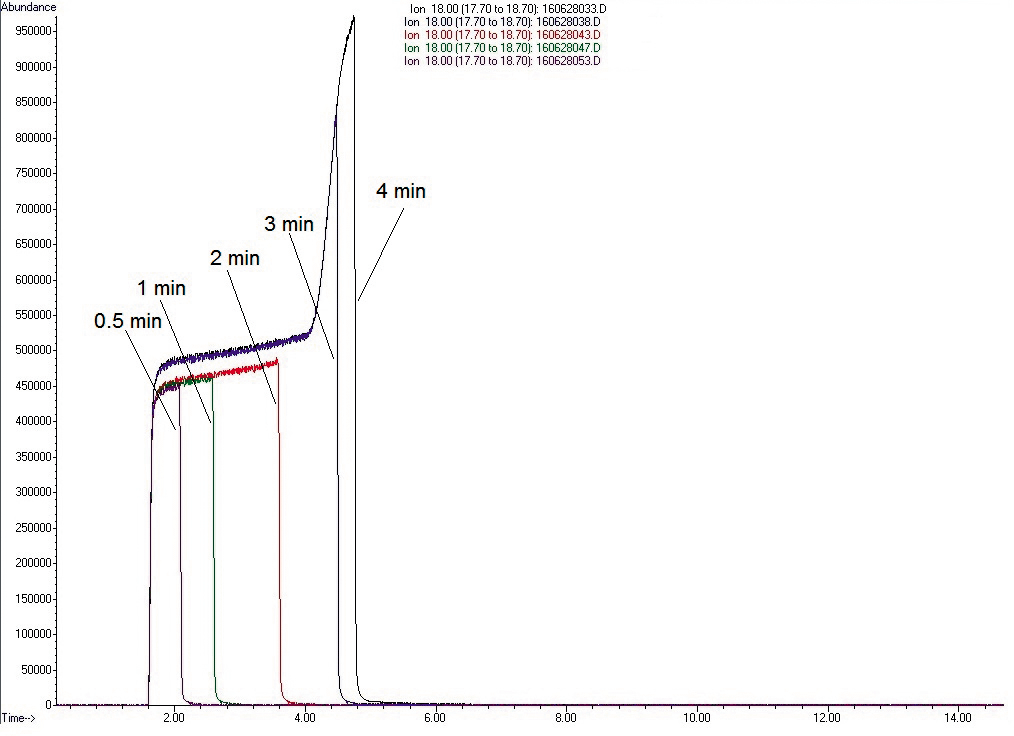Exploring the US EPA 524 Purge and Trap Variables
The Application Notebook
Purge and trap concentration is used for the analysis of volatile organic compounds (VOCs) in water. An issue with the technique is while purge gas strips VOCs from water it also collects water vapor, negatively affecting GC–MS systems.
This application note will investigate the roles of various purge parameters as tools for reducing water vapor transfer, and how the Lumin moisture control system (MCS) affects these parameters. Using the US EPA Method 524 series, the dry purge time and the trap desorb time will be investigated.
Moisture Control System
The Lumin MCS eliminates the need for dry purge by removing more water from the purge flow path than previous designs. In order to quantify the amount of water vapor transferred to the mass spectrometer, area counts of m/z 18 peaks were compared between the Lumin and the Stratum, using varying dry purge times. Figure 1 compares the amount of water transferred between the Lumin and Stratum.

Figure 1: Comparison of the amount of water transferred to the GC–MS between the Stratum and the Lumin with various dry purge times.
Desorb Time
The desorb time was also investigated using US EPA methods 524.3 and 524.4. Water transferred with a desorb time from 0.5 min to 4 min was examined, along with compound recoveries at each.
Five replicates of 10 ppb standards were tested. The standard mix included 95 target compounds, internal, and surrogate standards. Their peak areas were averaged and compared as a percent of the 0.5 min desorb time (data not shown). All but four of the compounds fell within 20% of the 0.5 min desorb time results. These four were polar compounds that typically have poor purge efficiency.
Water vapor was also compared at each desorb time (Figure 2). Each additional minute roughly doubled the amount of water introduced to the GC, from minutes 1 to 3. A less significant increase was seen from 3 to 4 min, likely suggesting that the majority of water is removed within 3 min at the desorb flow rate used in this study.

Figure 2: Comparison of the specific ion chromatogram of water (m/z 18) transferred to the GC–MS for trap desorb times from 0.5 to 4 min.
Conclusion
The Lumin MCS reduces the amount of water vapor transferred to a GC–MS system by at least 50% over current moisture control devices when no dry purge is used. This effectively reduces the purge and trap cycle time by 1 min or more. Additionally, further water reduction can be achieved through selection of a desorb time between 0.5 and 2 min. By reducing water vapor, analysts can achieve better reproducibility and reduce GC–MS maintenance.
References
(1) U.S. Environmental Protection Agency, Method 524.2 - Measurement of Purgeable Organic Compounds in Water by Capillary Column Gas Chromatography/Mass Spectrometry, (U.S. EPA, Washington, D.C., 1995).
(2) U.S. Environmental Protection Agency, Method 524.3. Measurement of Purgeable Organic Compounds in Water by Capillary Column Gas Chromatography/Mass Spectrometry, (U.S. EPA, Washington, D.C., 2009)
(3) U.S. Environmental Protection Agency, Method 524.4, Measurement of Purgeable Organic Compounds in Water by Gas Chromatography/Mass Spectrometry using Nitrogen Purge Gas, (U.S. EPA, Washington, D.C., May 2013).

Teledyne Tekmar
4736 Socialville Foster Rd., Mason, OH 45040
tel. (513) 229-7000
Website: www.teledynetekmar.com

Separation of Ultra-Short and Long Chain PFAS Compounds Using a Positive Charge Surface Column
December 11th 2024A separation of ultra-short and long chain PFAS (C1-C18) is performed on a HALO®PCS Phenyl-Hexyl column along with a HALO®PFAS Delay column which demonstrates excellent retention for both hydrophilic and hydrophobic analytes.

.png&w=3840&q=75)

.png&w=3840&q=75)



.png&w=3840&q=75)



.png&w=3840&q=75)










